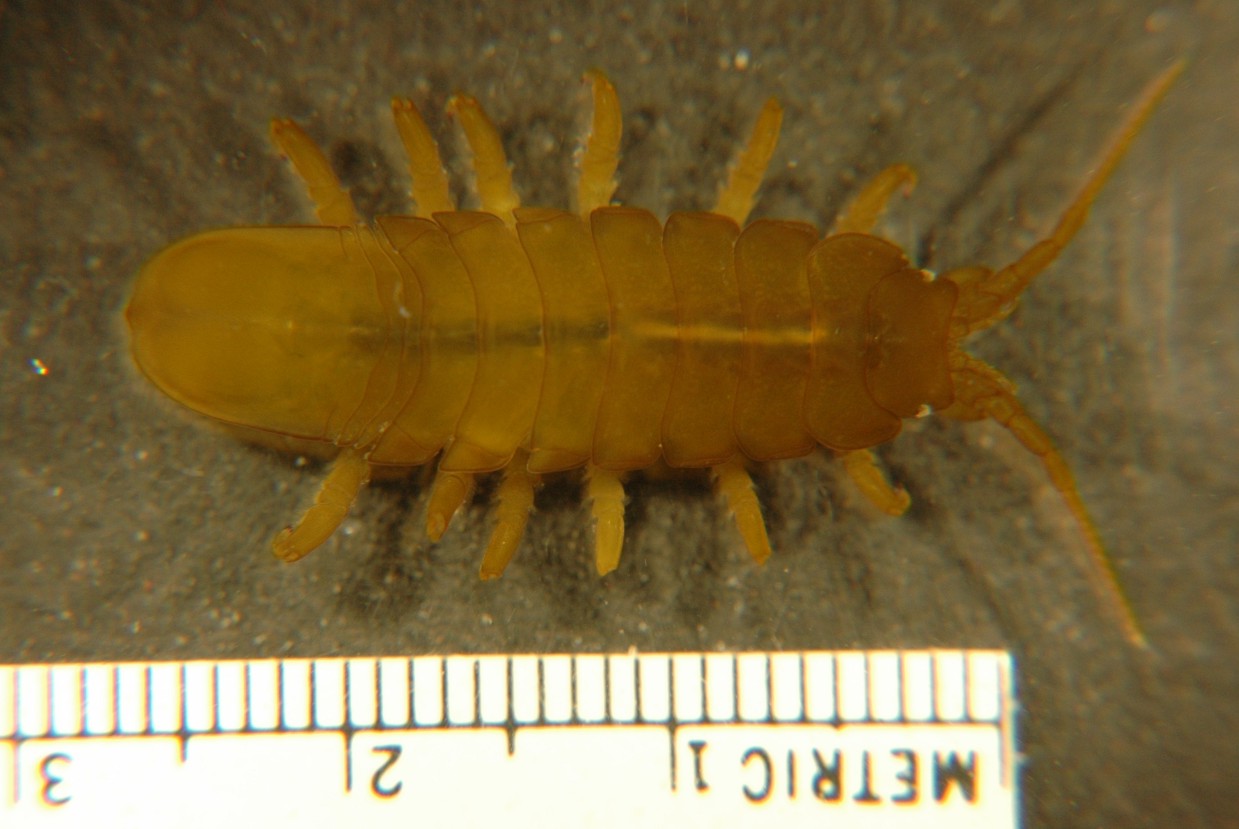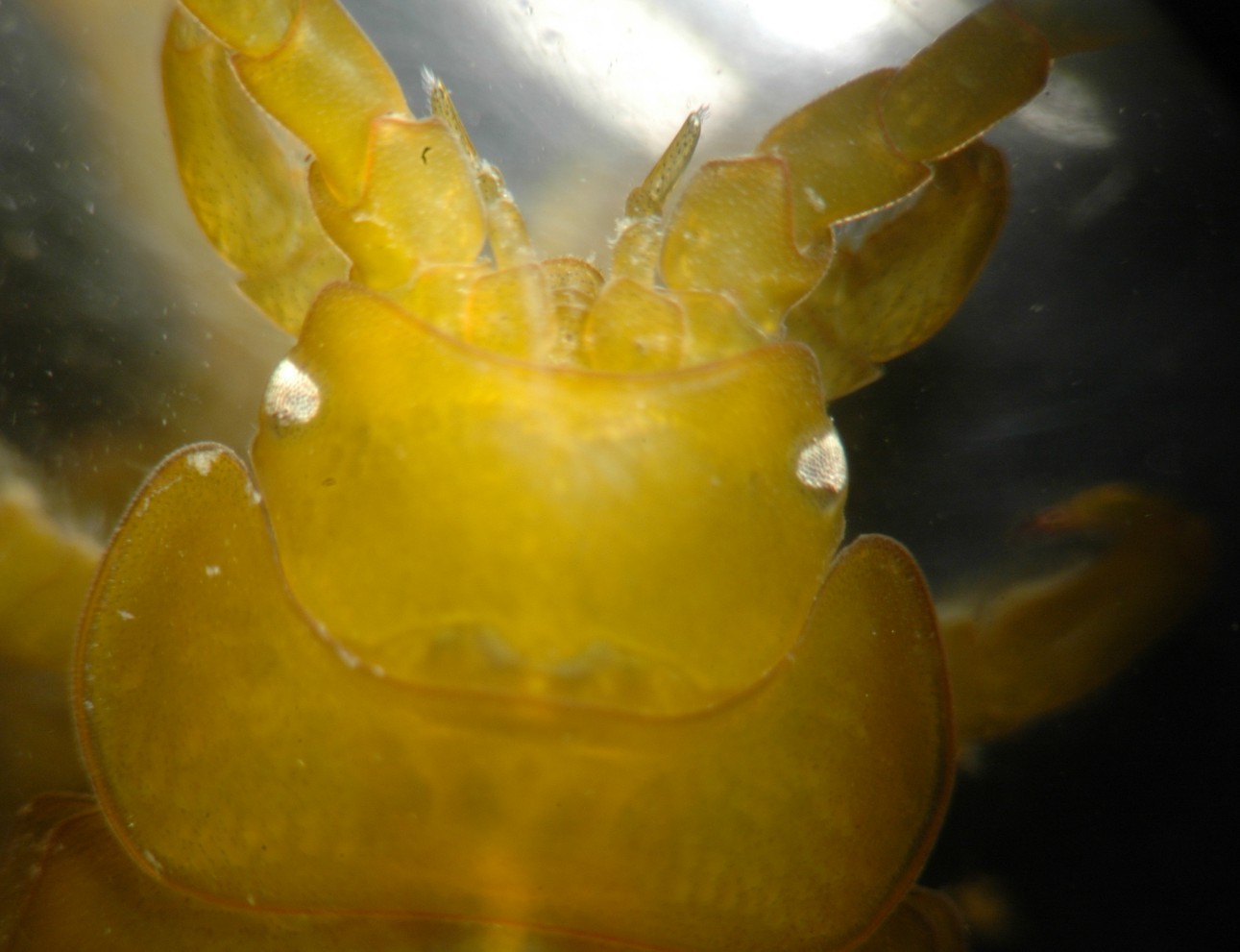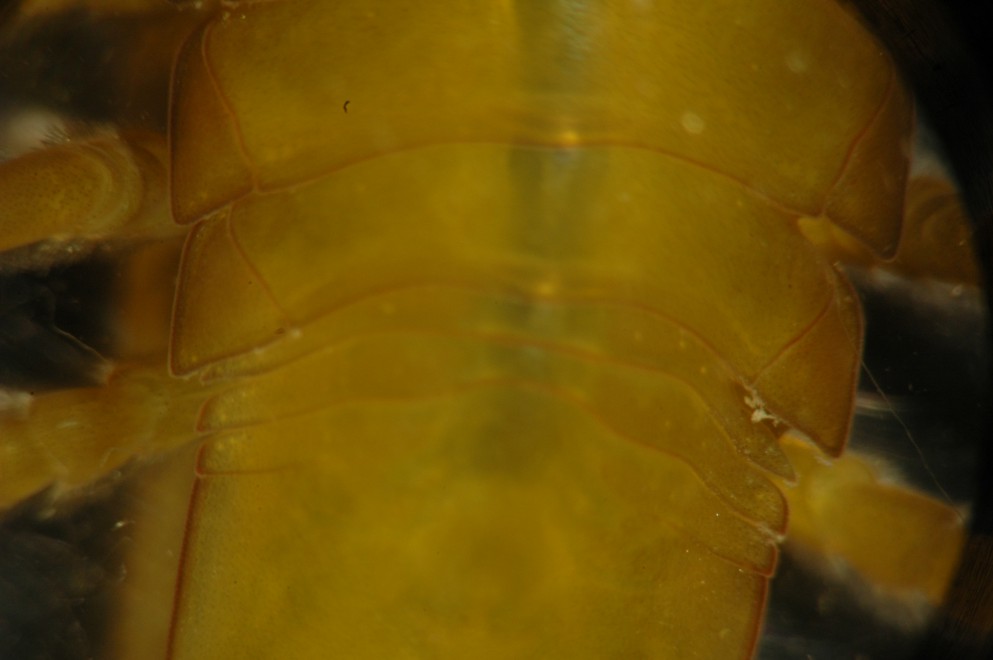Pentidotea wosnesenskii (Brandt, 1851)Common name(s): Rockweed isopod, Olive green isopod, Vosnesensky's isopod |
|
| Synonyms: Idotea wosnesenskii, Idothea wosnesenskii |  |
| Phylum Arthropoda
Subphylum Crustacea Class Malacostraca Subclass Eumalacostraca Superorder Peracarida Order Isopoda Suborder Valvifera Family Idoteidae |
|
| Pentidotea wosnesenskii from Padilla Bay. | |
| (Photo by: Dave Cowles, July 2006) | |
How to Distinguish from Similar Species: Of the species with a convex posterior margin to the pleotelson, several species look similar but pleonite 1 is not narrower laterally than in the center. Several others have a more slender body with all the pereonites about the same width. Idotea aculeata, in the southern part of the range, looks similar but has round eyes instead of kidney-shaped.
Geographical Range: Alaska to central CA; Sea of Okhotsk, USSR.
Depth Range: Mid intertidal to 16 m
Habitat: Often abundant in kelp, in mussel beds, and under intertidal rocks.
Biology/Natural History: Eats algae. May also eat the egg capsules of Nucella emarginata. Predators include fish such as the spotted kelpfish Gibbonsia elegans and dwarf perch Micrometrus minimus. This species can swim well, using its pleopods (it opens the flaps of the uropods to expose the pleopods). Males are usually larger and paler than females and have thicker legs. Ovigerous females have been found in July, and a female was seen brooding 3-4 mm young in November in SE Alaska.
The 5 pairs of pleopods on the abdomen are enclosed within a branchial chamber formed by the uropods, which serve as operculae. The first three pairs are designated as swimming pleopods and the last 3 as ventilatory, but all 5 are used in ventilation using a stroke similar to that used while swimming. Ventilatory strokes are usually slower than swimming strokes and are often separated by resting phases. Sometimes the operculae are opened farther to allow a larger-amplitude ventilatory stroke. It takes about 3 ventilatory strokes to pump water all the way through the branchial chamber (Alexander, 1991). This species has a higher drag coefficient and is a slower swimmer (about 0.1 m/second) than is Pentidotea resecata (Alexander and Chen, 1990).
The species is named for the Russian zoologist Ilya Gavrilovich Vosnesensky,
who collected and studied species from Siberia, Alaska, and California
from 1839-1848
| Return to: | |||
| Main Page | Alphabetic Index | Systematic Index | Glossary |
References:
Dichotomous Keys:Flora and Fairbanks, 1966
Kozloff 1987, 1996
Smith and Carlton, 1975
General References:
Harbo,
1999
Kozloff,
1993
McConnaughey
and McConnaughey, 1985
Morris
et al., 1980
Niesen,
1997
O'Clair
and O'Clair, 1998
Ricketts
et al., 1985
Sept,
1999
Scientific Articles:
Alexander,
David E., 1991. Mechanics of branchial ventilation in the valviferan
isopod Idotea wosnesenskii
(Crustacea). Journal of Zoology 224:4 pp 607-616
Alexander, David E. and Tao Chen, 1990. Comparison of swimming speed and hydrodynamic drag in two species of Idotea (Isopoda). Journal of Crustacean Biology 10:3 pp. 406-412. doi.org/10.2307/1548330
Web sites:
General Notes and Observations: Locations, abundances, unusual behaviors:

In this closeup of the head (cephalon)
one can see the lateral eyes (kidney-shaped when viewed from the side)
and the fact that the first pereonite
is much wider than the cephalon.

In this view of the underside of the head one can see the palp
along the side of the third maxilliped,
which is covering the mouth (the dark mandibles
are visible between the third maxillipeds).
The palp
has 5 segments.

This view shows the last two pereonites
(at top), then the two free pleonites
and the front of the pleotelson.
The lateral plates seen on the pereonites
are actually coxal
plates. Note that the posterolateral margin of the coxal
plate from the last (7th) pereonite
is pointed (acute)
The first pleonite
is narrow or acute
at the edge, much narrower than it is mid-dorsally.
Note the notch at the sides of the front of the pleotelson
showing the margin of a third partly free pleonite.

In this ventral view one can see the 7 similar pereopods
on the pereon,
and the flaplike ventral uropods
which are characteristic of suborder Valvifera and cover the pleopods
on the pleotelson.
Authors and Editors of Page:
Dave Cowles (2006): Created original page